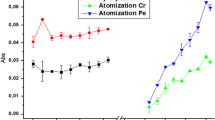Abstract
Inductively coupled plasma atomic emission spectroscopy (ICP-AES) was used for routine analysis of small samples of human milk. The concentrations of calcium (Ca), copper (Cu), iron (Fe), magnesium (Mg), manganese (Mn), phosphorus (P), and zinc (Zn) were determined in 203 milk samples from postpartum women at different stages of lactation after stepwise digestion in HNO3, HCIO4, and H2O2 under heat. Validation of the procedure was achieved using certified reference material of bovine liver (NBS 1577) with mean recoveries of 103.5%. The concentrations of the above elements in milk matrix were comparable with previously reported values. The analytical results from breast milk will provide reference information for mineral studies of Brazilian mothers and breast-fed infants.
Similar content being viewed by others
References
R. M. Barnes, Advantages in inductively coupled plasma mass spectrometry: Human nutrition and toxicology,Anal. Chim. Acta 283, 115–130 (1993).
S. F. Durrand and N. I. Ward, Multi-elemental analysis of human milk by inductively coupled plasma-source mass spectrometry: implications for infant health,J. Micronutr. Anal. 5, 111–126 (1989).
S. Emmet, Analysis of liquid milk by inductively coupled plasma mass spectrometry,J. Anal. Spectrom. 3, 1145–1146 (1988).
E. Coni, A. Stachini, S. Caroli, and P. Falconeri, Analytical approach to obtaining reference values for minor and trace elements in human milk,J. Anal. Atomic Spectrom. 5, 581–586 (1990).
L. J. Martines Stewart, and R.M. Barnes, Flow-through, microwave-heated digestion chamber for automated sample preparation prior to inductively coupled plasma spectrochemical analysis,Analyst 119, 1003–1110 (1994).
T. Alkanani, J. K. Friel, S. E. Jackson, and H. P. Longerich, Comparison between digestion procedures for the multielemental analysis of milk by inductively coupled plasma mass spectrometry,J. Agric. Food Chem. 42, 1695–1697 (1994).
M. G. De la Fuente and M. Juarez, Rapid determination of calcium, magnesium, sodium, and potassium in milk by flame atomic spectrometry after microwave oven digestion,Analyst 120, 107–111 (1995).
R. R. Anderson, Comparison of minerals in milk of four species.Comp. Biochem. Physiol. 100A, 1045–1048 (1991).
World Health Organization (WHO), Minor and Trace Elements in Breast Milk. Report of joint WHO/IAEA collaborative study, Geneva (1989).
J. G. Dorea, M. R. Horner, and M. Campanate, Lacteal zinc and copper in relation to volume total ash and energy during the first three months of lactation,Acta Paediatr. Scand. 74, 891–896 (1985).
Author information
Authors and Affiliations
Rights and permissions
About this article
Cite this article
Silva, P.R.M., Dorea, J.G. & Boaventura, G.R. Multielement determination in small samples of human milk by inductively coupled plasma atomic emission spectrometry. Biol Trace Elem Res 59, 57–62 (1997). https://doi.org/10.1007/BF02783230
Received:
Revised:
Accepted:
Issue Date:
DOI: https://doi.org/10.1007/BF02783230




